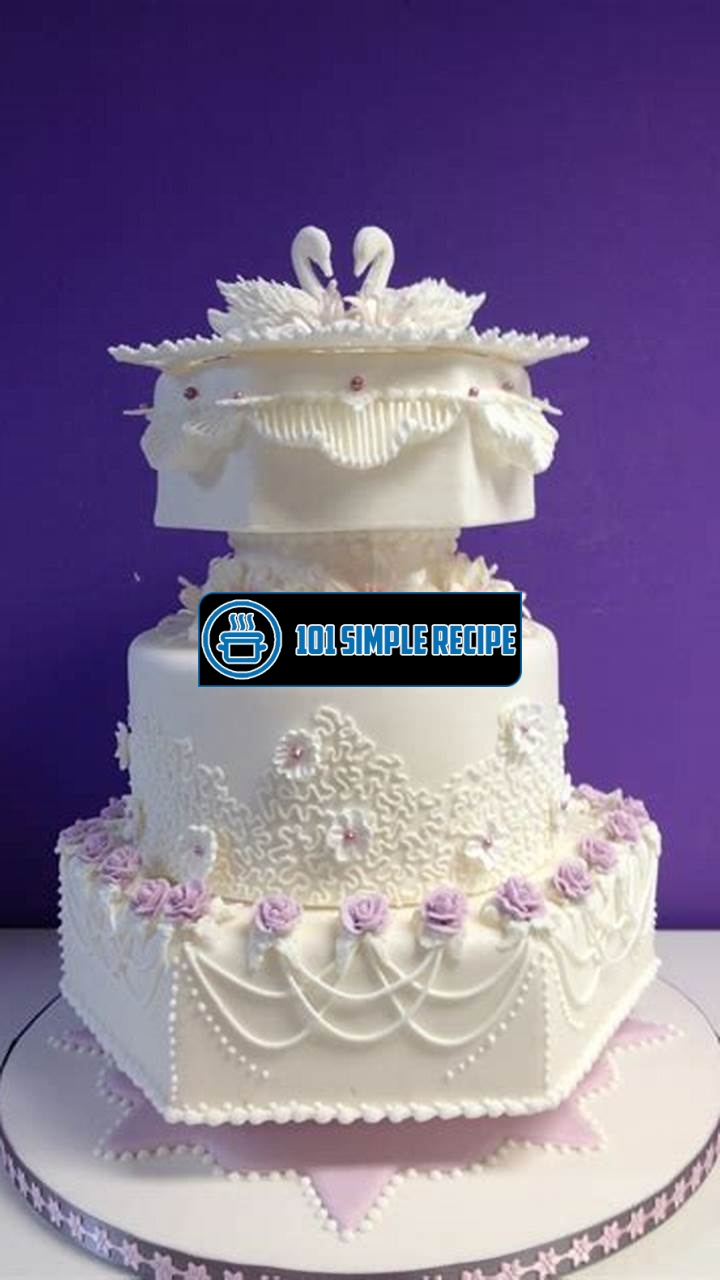If you want to elevate your cake decorating skills to the next level, mastering the art of royal icing is essential. This versatile icing is not only beautiful but also adds a touch of elegance and sophistication to any cake. Whether you’re a professional baker or a baking enthusiast, learning how to work with royal icing opens up a world of possibilities for creating stunning and intricate designs. In this article, we will guide you through the process of mastering royal icing, providing you with expert tips and techniques along the way. So get ready to take your cake decorating game to new heights! ✨

The Basics of Royal Icing for Cakes
When it comes to cake decorations, royal icing is a timeless and versatile option that every aspiring baker should master. This classic icing is not only visually stunning but also allows for intricate designs and details. In this article, we will delve into the essential knowledge about royal icing, including what it is, its benefits, and common uses.
What is Royal Icing?
Royal icing is a type of icing that hardens when it dries, making it perfect for decorative purposes. It is made from simple ingredients such as powdered sugar, egg whites, and sometimes lemon juice or cream of tartar. The combination of these ingredients creates a smooth and glossy finish that can be piped onto cakes and cookies.
- Eager to learn more about royal icing? Keep reading!
Benefits of Using Royal Icing
Royal icing offers several benefits that make it a popular choice among bakers and decorators. Firstly, it provides a clean and polished look to any cake. The smooth surface achieved with royal icing allows for intricate designs and details, making it the go-to choice for special occasions and professional bakers.
Another advantage of using royal icing is its ability to create dimension. Unlike other icings, royal icing hardens when it dries, allowing you to build layers and add depth to your cake decorations. This makes it ideal for creating 3D designs and structures.
Furthermore, royal icing is incredibly versatile. It can be tinted in various colors using food coloring, and different consistencies can be achieved by adjusting the amount of water added. From delicate lacework to piped flowers, royal icing can be molded and shaped to suit any design or theme.
- Discover the endless possibilities of royal icing for your cake decorations!
Common Uses for Royal Icing
Royal icing is not just limited to cakes; it is also commonly used to decorate cookies, cupcakes, and gingerbread houses. Its firm texture ensures that the decorations stay intact, even in warm weather or during transportation.
One of the most popular uses for royal icing is creating intricate designs on wedding cakes. From delicate lace patterns to intricate sugar flowers, royal icing can elevate the elegance and grandeur of any wedding cake.
In addition, royal icing can be used to assemble and decorate gingerbread houses during the festive season. Its hardening properties ensure the stability of the structure while allowing you to add intricate details such as shingles, windows, and doors.
Furthermore, royal icing is a great way to add a personal touch to cookies. Whether you want to pipe names, messages, or intricate designs on your sugar cookies, royal icing provides the perfect medium for creative expression.
- Express your creativity and make your desserts stand out with royal icing!
In conclusion, royal icing is a must-have skill for any baker or cake decorator. Its versatility, ability to create intricate designs, and firm texture make it an ideal choice for various desserts. Whether you’re creating a wedding cake, decorating cookies, or building a gingerbread house, royal icing is sure to impress. Embrace your creativity and master the art of royal icing for cakes today!
Preparing Royal Icing
Are you ready to become a master of royal icing for cakes? In this article, we will guide you through the step-by-step process of making royal icing from scratch. Let’s dive in and discover the secrets of creating beautifully decorated cakes!
Gathering the Necessary Ingredients
To begin your royal icing journey, it’s important to gather all the necessary ingredients. Here’s what you’ll need:
- Egg whites (fresh or pasteurized): 2 large eggs
- Confectioners’ sugar: 4 cups
- Lemon juice: 1 teaspoon
- Food coloring (optional): a few drops
- Water: as needed for desired consistency
Note: Some people prefer to use meringue powder instead of fresh egg whites to avoid the risk of salmonella. If you choose to go this route, substitute 3 tablespoons of meringue powder for the 2 egg whites.
Tip: Make sure all the ingredients are at room temperature for optimal results. This will help with the mixing and ensure a smooth consistency.
Measuring and Mixing the Ingredients
Now that you have all the ingredients ready, it’s time to measure and mix them together. Follow these steps:
- Step 1: Separate the egg whites from the yolks and place them in a clean, grease-free mixing bowl.
- Step 2: Sift the confectioners’ sugar to remove any lumps. This will result in a smoother icing.
- Step 3: Gradually add the sifted confectioners’ sugar to the egg whites. Mix well after each addition until all the sugar is fully incorporated.
- Step 4: Add the lemon juice to the mixture and continue to mix until the icing becomes smooth and glossy.
Tip: If you desire colored royal icing, now is the time to add a few drops of food coloring. Remember to start with a small amount and adjust to achieve the desired shade.
Tips for Achieving the Right Consistency
The consistency of your royal icing is crucial for achieving different decorating techniques. Here are some tips to help you achieve the right consistency:
- Thick Consistency: For outlining or creating intricate designs, such as lace patterns, you’ll want a thicker icing. Add less water to achieve a stiffer consistency.
- Flooding Consistency: If you’re planning to flood the surface of a cookie or cake with icing, you’ll need a thinner consistency. Gradually add small amounts of water until the icing smoothly flows off your spoon.
- Soft Peak Consistency: For delicate designs like flowers or ruffles, you’ll need a medium consistency. Test the icing by lifting your spoon; if the peak slightly droops, you’re on the right track.
Tip: It’s better to start with a thicker consistency and gradually add water, as needed, to avoid ending up with icing that is too runny.
With these expert tips in mind, you’re now equipped to master the art of royal icing for cakes. Get creative, experiment with different techniques, and let your imagination run wild as you decorate stunning and delicious cakes!
Techniques for Applying Royal Icing
Royal icing is a versatile and essential component in cake decoration. It is the perfect medium to create intricate designs and add a touch of elegance to any cake. In this article, we will explore various techniques for applying royal icing, including piping, flooding, and creating dimension. So, let’s dive in and master the art of royal icing for cakes!
Piping with Royal Icing
Piping is a classic technique that involves using a piping bag fitted with a decorative tip to pipe intricate designs onto the cake. It allows you to create delicate flowers, intricate borders, and personalized messages. To achieve the best results, follow these steps:
- Prepare your royal icing: Begin by preparing the royal icing recipe for cakes. Choose the consistency that suits your design – for fine details, use a stiffer consistency, while for filling larger areas, opt for a more fluid consistency.
- Fill the piping bag: Transfer the prepared royal icing into a piping bag fitted with your desired tip. Twist the top of the piping bag to secure the icing inside.
- Pipe your design: Apply gentle pressure to the piping bag and guide it over the cake to create your desired design. Practice steady, even pressure for consistent lines and shapes.
- Dry the icing: Allow the piped royal icing to dry completely before moving on to the next step or adding additional layers of icing to avoid smudging or blending of colors.
Note: Experiment with different piping tips to achieve a variety of designs and textures. Don’t be afraid to unleash your creativity!
Flooding Technique with Royal Icing
The flooding technique is perfect for creating smooth, glossy surfaces or filling larger areas with royal icing. Here’s how to achieve a flawless flood:
- Prepare your royal icing: To flood your design, prepare a more fluid royal icing by adding a small amount of water to your base icing. The consistency should be thin enough to smoothly spread but not too runny.
- Outline your design: Use a stiffer royal icing consistency, usually in a contrasting color, to outline the area you want to flood. This creates a dam, preventing the icing from spreading beyond the desired boundary.
- Flood the area: Fill a piping bag with your thinner royal icing and carefully fill the outlined area, using a toothpick or a small offset spatula to spread the icing evenly.
Allow the flooded icing to set and dry before adding additional details. This technique is perfect for creating a solid base for more intricate designs, like monograms or sugar flowers.
Creating Dimension with Royal Icing
Creating dimension with royal icing adds depth and visual interest to your cake designs. There are several techniques to achieve dimensional effects:
- Layering: Apply different layers of royal icing in varying thicknesses to create depth and a three-dimensional effect. This technique is commonly used for ruffles, waves, and lace-like patterns.
- Embossing: Use textured mats or molds to imprint patterns onto the royal icing. These can be delicate lace-like patterns, floral imprints, or geometric designs. The embossed areas can be left as is or highlighted with edible luster dust for added shimmer.
- Modeling: Royal icing can be sculpted into three-dimensional shapes like flowers, bows, or figurines. This technique requires a stiffer consistency of royal icing that can hold its shape. Once dried, the models can be painted or dusted with edible colors to enhance their appearance.
By incorporating these techniques into your cake decorating skills, you can create stunning cakes that are the centerpiece of any celebration.
Decorative Effects with Royal Icing
Discover the endless possibilities of designs and effects that can be achieved with royal icing. Royal icing is a versatile and popular choice for decorating cakes, cookies, and other baked goods. Its smooth and glossy consistency, when properly applied, can create stunning decorative effects. Whether you’re a professional baker or a home enthusiast, mastering the art of royal icing will elevate your cake decorating skills to new heights.
Adding Intricate Details
When it comes to adding intricate details to your cake designs, royal icing is your secret weapon. Its ability to hold its shape and dry hard makes it perfect for piping delicate patterns, fine lines, and intricate lace-like designs. With a steady hand and some practice, you can create elegant scrolls, intricate filigree, and even lifelike flowers with royal icing. The fine tip of a piping bag filled with royal icing allows for precise control, giving you the freedom to add those eye-catching details that will wow your guests.
Creating Texture and Patterns
Royal icing also allows you to create various textures and patterns on your cakes. With the right consistency, you can achieve smooth surfaces or textured finishes like ruffles, waves, or petal-like patterns. You can use different tips and techniques to create a multitude of effects, from basketweave designs to quilted patterns. The versatility of royal icing gives you the freedom to let your creativity shine and create cakes that are not only visually appealing but also tactilely interesting.
Using Royal Icing for 3D Elements
One of the lesser-known uses of royal icing is for creating 3D elements on cakes. Building structures, such as castles or sculptures, can be achieved by piping royal icing and allowing it to dry and harden. The hardened royal icing acts as a sturdy support structure, allowing you to create intricate and gravity-defying designs. From creating decorative toppers to constructing entire scenes, the only limit is your imagination. With royal icing, you can bring your cake designs to life and impress your guests with awe-inspiring creations.
In conclusion, mastering the art of royal icing opens up a world of creative possibilities for cake decorators. From adding intricate details to creating texture and patterns, this versatile icing can elevate your cake designs to new heights. By utilizing royal icing for 3D elements, you can create show-stopping cakes that are not only visually stunning but also structurally impressive. So, grab your piping bag, practice your techniques, and let your imagination run wild as you master the art of royal icing.
Troubleshooting Common Royal Icing Issues
Working with royal icing can be a challenging task, even for experienced bakers. But fear not! In this section, we will explore some common issues that may arise when working with royal icing and provide you with valuable tips and tricks to overcome them. So, let’s dive right in and master the art of troubleshooting royal icing!
Fixing Runny Royal Icing ♀️
One of the most frustrating problems you may encounter is when your royal icing turns out too runny. This can happen due to various reasons, such as using too much liquid or not adding enough sugar. Don’t worry, though! Here’s what you can do to fix it:
- Gradually add more sifted confectioners’ sugar to thicken the icing. Be sure to mix well after each addition to achieve the desired consistency.
- If you accidentally added too much liquid, try incorporating some stiff royal icing into the runny batch. This will help to thicken it up.
- If all else fails, let the icing sit uncovered for some time to allow it to dry out and thicken naturally. Keep an eye on it and test the consistency periodically.
Dealing with Cracking or Hardening Issues
Cracking or hardening of royal icing can be a common problem, especially when it’s exposed to air for an extended period. To prevent or remedy this issue, consider the following suggestions:
- Keep your royal icing covered with plastic wrap while working to prevent it from drying out and forming a crust. This can help maintain its smoothness.
- If your icing has already hardened, you can try adding a small amount of liquid, such as water or lemon juice, and gently mixing it in. This may help to soften the consistency and reduce cracking.
- If the cracking is minimal, you can use a small paintbrush or a food-safe spritzer to lightly moisten the cracked areas, which can help to mend them together.
Avoiding Air Bubbles in Royal Icing
Air bubbles in royal icing can create unwanted imperfections and ruin the overall appearance of your cake. To ensure a smooth and bubble-free surface, follow these tips:
- Begin by preparing your royal icing with a gentle stirring motion rather than vigorous beating. This will help minimize the incorporation of air into the mixture.
- Before applying the icing to your cake, let it rest for a few minutes to allow any trapped air bubbles to rise to the surface.
- Use a toothpick or a scribe tool to gently pop any visible air bubbles on the surface of the icing. Be careful not to damage the underlying layer.
- Consider using a decorating bag fitted with a tip that has a small opening to minimize the chances of air being trapped.
Note: Patience is key when working with royal icing. Take your time and practice these troubleshooting techniques to become a master in no time!
Now that you’ve learned how to troubleshoot common royal icing issues, you’re well-equipped to handle any challenges that come your way. So, go ahead and confidently create stunning cakes with flawlessly smooth royal icing!
Thank you for taking the time to read our article on the royal icing recipe for cakes. We hope you found the information helpful and inspiring for your next baking adventure. Remember, practice makes perfect, so don’t be afraid to experiment and add your own creative twist to this classic recipe. If you have any questions or suggestions, feel free to leave a comment below. And don’t forget to visit us again for more delicious recipes and baking tips. Happy baking!
Frequently Asked Questions
Here are some common questions about making royal icing for cakes:
| No. | Questions | Answers |
|---|---|---|
| 1. | What is royal icing? | Royal icing is a smooth, hard-drying icing that is commonly used for decorating cakes, cookies, and other baked goods. It is made from a mixture of powdered sugar, egg whites, and sometimes lemon juice or cream of tartar. Its consistency can be adjusted to achieve different decorating effects, from thin and flowing for flooding designs to thick and stiff for intricate piped decorations. |
| 2. | Can I use royal icing on any type of cake? | Absolutely! Royal icing can be used on any type of cake, from butter cakes to sponge cakes. It adheres well to the surface of the cake and dries to a smooth, glossy finish, making it perfect for decorating and adding intricate designs. Just make sure to let the icing dry completely before serving or stacking the cake layers. |
| 3. | How long does it take for royal icing to dry? | The drying time for royal icing can vary depending on the thickness of the icing and the humidity in your environment. Generally, it takes about 6 to 8 hours for the icing to dry to the touch and around 24 hours for it to fully harden. If you’re in a hurry, you can use a fan or a dehumidifier to speed up the drying process. |
| 4. | Can I color royal icing? | Yes, you can easily color royal icing using gel or powdered food coloring. Start with a small amount of coloring and gradually add more until you achieve the desired shade. Keep in mind that royal icing darkens slightly as it dries, so it’s best to make the color slightly lighter than what you want the final result to be. |
| 5. | How long does royal icing last? | Royal icing can last for several weeks if stored properly. It should be kept in an airtight container at room temperature, away from direct sunlight and moisture. If the icing starts to dry out or harden, you can add a few drops of water and mix it thoroughly to restore its consistency. |
| 6. | Can I freeze royal icing? | Yes, you can freeze royal icing for up to 3 months. Make sure to store it in an airtight container or freezer bag to prevent freezer burn. When you’re ready to use it, thaw it in the refrigerator overnight and bring it to room temperature before using. If the consistency has changed after thawing, you can add a few drops of water and mix well to adjust it. |
Celebrate with Royal Icing
Now that you’ve mastered the art of making royal icing, it’s time to let your creativity soar. Whether you’re decorating a birthday cake, holiday cookies, or a special occasion dessert, royal icing is a versatile and elegant way to add flair to your creations. So go ahead, gather your ingredients, and let your inner cake artist shine. Remember, practice makes perfect, so don’t be discouraged if your first attempts are not picture-perfect. Enjoy the process, have fun, and most importantly, savor every delicious bite. Happy baking!
Jump to Recipe
Royal Icing Recipe for Cakes

Learn how to make the perfect royal icing for cakes, cookies, and other baked goods. With just a few simple ingredients and some practice, you’ll be able to create beautiful and delicious treats for any occasion.
- 1 1/2 cups powdered sugar
- 1 large egg white
- 1/2 teaspoon lemon juice
- In a mixing bowl, combine the powdered sugar, egg white, and lemon juice.
- Using an electric mixer, beat the mixture on low speed until well combined.
- Increase the speed to medium-high and continue beating until the icing forms stiff peaks.
- Transfer the icing to a piping bag fitted with a desired tip.
- Decorate your cakes, cookies, or other baked goods as desired.
- Allow the icing to dry completely before serving or stacking the cake layers.






